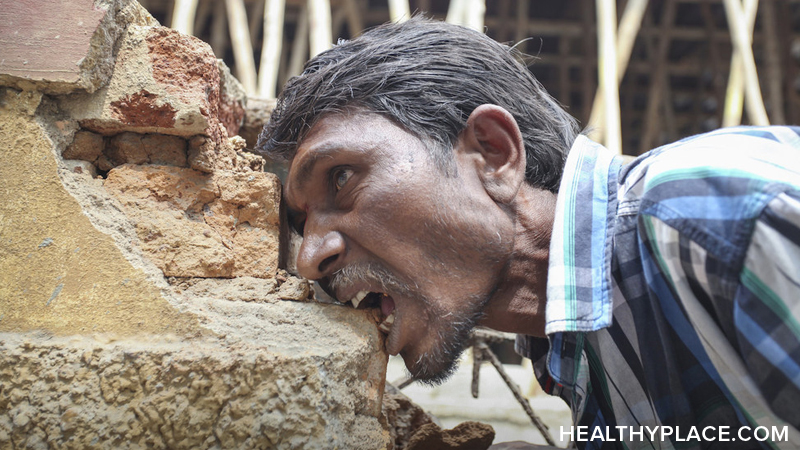Eating Disorders: Pica
Background:
Pica is an eating disorder typically defined as the persistent eating of nonnutritive substances for a period of at least 1 month at an age in which this behavior is developmentally inappropriate (eg, >18-24 mo). The definition occasionally is broadened to include the mouthing of nonnutritive substances. Individuals presenting with pica have been reported to mouth and/or ingest a wide variety of nonfood substances, including, but not limited to, clay, dirt, sand, stones, pebbles, hair, feces, lead, laundry starch, vinyl gloves, plastic, pencil erasers, ice, fingernails, paper, paint chips, coal, chalk, wood, plaster, light bulbs, needles, string, and burnt matches.
Although pica is observed most frequently in children, it is the most common eating disorder seen in individuals with developmental disabilities. In some societies, pica is a culturally sanctioned practice and is not considered to be pathologic. Pica may be benign, or it may have life-threatening consequences.
In children aged 18 months to 2 years, the ingestion and mouthing of nonnutritive substances is common and is not considered to be pathologic. Consider pica when the behavior is inappropriate to the developmental level of the individual, is not part of a culturally sanctioned practice, and does not occur exclusively during the course of another mental disorder (eg, schizophrenia). If pica is associated with mental retardation or pervasive developmental disorder, it must be sufficiently severe to warrant independent clinical attention. In such patients, pica typically is considered to be a secondary diagnosis. Furthermore, the pica must last for a period of at least 1 month.
Pathophysiology:
Pica is a serious behavioral problem because it can result in significant medical sequelae. The nature and amount of the ingested substance determine the medical sequelae. Pica has been shown to be a predisposing factor in accidental ingestion of poisons, particularly in lead poisoning. The ingestion of bizarre or unusual substances also has resulted in other potentially life-threatening toxicities, such as hyperkalemia following cautopyreiophagia (ingestion of burnt match heads).
Exposure to infectious agents via ingestion of contaminated substances is another potential health hazard associated with pica, the nature of which varies with the content of the ingested material. In particular, geophagia (soil or clay ingestion) has been associated with soil-borne parasitic infections, such as toxoplasmosis and toxocariasis. Gastrointestinal (GI) tract complications, including mechanical bowel problems, constipation, ulcerations, perforations, and intestinal obstructions, have resulted from pica.
Frequency:
- In the US: Prevalence of pica is unknown because the disorder often is unrecognized and underreported. Although prevalence rates vary depending on the definition of pica, the characteristics of the population sampled, and the methods used for data collection, pica is reported most commonly in children and in individuals with mental retardation. Children with mental retardation and autism are affected more frequently than children without these conditions. Among individuals with mental retardation, pica is the most common eating disorder. In this population, the risk for and severity of pica increases with increasing severity of mental retardation.
- Internationally: Pica occurs throughout the world. Geophagia is the most common form of pica in people who live in poverty and people who live in the tropics and in tribe-oriented societies. Pica is a widespread practice in western Kenya, southern Africa, and India. Pica has been reported in Australia, Canada, Israel, Iran, Uganda, Wales, and Jamaica. In some countries, Uganda for example, soil is available for purchase for the purpose of ingestion.
Mortality/Morbidity:
- Ingestion of poisons: Lead toxicity is the most common type of poisoning associated with pica. Lead has neurologic, hematologic, endocrine, cardiovascular, and renal effects. Lead encephalopathy is a potentially fatal complication of severe lead poisoning, presenting with headache, vomiting, seizures, coma, and respiratory arrest. Ingestion of high doses of lead can cause significant intellectual impairment and behavioral and learning problems. Studies also have demonstrated that neuropsychologic dysfunction and deficits in neurologic development can result from very low lead levels, even levels once believed to be safe.
- Exposure to infectious agents: A variety of infections and parasitic infestations, ranging from mild to severe, are associated with the ingestion of infectious agents via contaminated substances, such as feces or dirt. In particular, geophagia has been associated with soil-borne parasitic infections, such as toxocariasis, toxoplasmosis, and trichuriasis.
- GI tract effects: GI tract complications associated with pica range from mild (eg, constipation) to life threatening (eg, hemorrhages secondary to perforations or ulcerations). Sequelae in the GI tract may include mechanical bowel problems, constipation, ulcerations, perforations, and intestinal obstructions caused by bezoar formation and the presence of undigestible materials in the intestinal tract.
- Direct nutritional effects: Theories regarding the direct nutritional effects of pica are related to characteristics of specific ingested materials that either displace normal dietary intake or interfere with the absorption of necessary nutritional substances. Examples of nutritional effects that have been linked to severe cases of pica include iron and zinc deficiency syndromes; however, the data are only suggestive, and no firm empirical data exist supporting these theories.
Race:
Although no specific data exist regarding racial predilection, the practice is reported to be more common among certain cultural and geographic populations. For example, geophagia is accepted culturally among some families of African lineage and is reported to be problematic in 70% of the provinces in Turkey.
Sex:
Pica typically occurs in equal numbers of boys and girls; however, it is rare in adolescent and adult males of average intelligence who live in developed countries.
Age:
- Pica is observed more commonly during the second and third years of life and is considered developmentally inappropriate in children older than 18-24 months. Research suggests that pica occurs in 25-33% of young children and 20% of children seen in mental health clinics.
- A linear decrease in pica occurs with increasing age. Pica occasionally extends into adolescence but is rarely observed in adults who are not mentally disabled.
- Infants and children commonly ingest paint, plaster, string, hair, and cloth. Older children tend to ingest animal droppings, sand, insects, leaves, pebbles, and cigarette butts. Adolescents and adults most often ingest clay or soil.
- In young pregnant women, the onset of pica frequently occurs during their first pregnancy in late adolescence or early adulthood. Although the pica usually remits at the end of the pregnancy, it may continue intermittently for years.
- In individuals with mental retardation, pica occurs most often in those aged 10-20 years.
History:
- Clinical presentation is highly variable and is associated with the specific nature of the resulting medical conditions and the ingested substances.
- A reluctance to report the practice and secretiveness on the part of patients frequently interfere with accurate diagnosis and effective treatment.
- The broad range of complications arising from the various forms of pica and the delay in accurate diagnosis may result in mild-to-life-threatening sequelae.
- In poisoning or exposure to infectious agents, the reported symptoms are extremely variable and are related to the type of toxin or infectious agent ingested.
- GI tract complaints may include constipation, chronic or acute and/or diffuse or focused abdominal pain, nausea, vomiting, abdominal distention, and loss of appetite.
- Patients may withhold information regarding pica behavior and deny the presence of pica when questioned.
Physical:
The physical findings associated with pica are extremely variable and are related directly to the materials ingested and the subsequent medical consequences.
- Toxic ingestions: Lead toxicity is the most common poisoning associated with pica.
- Physical manifestations are nonspecific and subtle, and most children with lead poisoning are asymptomatic.
- Physical manifestations of lead poisoning can include neurologic (eg, irritability, lethargy, ataxia, incoordination, headache, cranial nerve paralysis, papilledema, encephalopathy, seizures, coma, death) and GI tract (eg, constipation, abdominal pain, colic, vomiting, anorexia, diarrhea) symptoms.
- Infections and parasitic infestations: Toxocariasis (visceral larva migrans, ocular larva migrans) is the most common soil-borne parasitic infection associated with pica.
- Symptoms of toxocariasis are diverse and appear to be related to the number of larvae ingested and the organs to which the larvae migrate.
- Physical findings associated with visceral larva migrains may include fever, hepatomegaly, malaise, coughing, myocarditis, and encephalitis.
- Ocular larva migrans can result in retinal lesions and loss of vision.
- GI tract symptoms may be evident secondary to mechanical bowel problems, constipation, ulcerations, perforations, and intestinal obstructions caused by bezoar formation and the ingestion of undigestible materials into the intestinal tract.
Causes:
Although the etiology of pica is unknown, numerous hypotheses have been advanced to explain the phenomenon, ranging from psychosocial causes to causes of purely biochemical origin. Cultural, socioeconomic, organic, and psychodynamic factors have been implicated.
- Nutritional deficiencies:
- Although firm empirical data supporting any of the nutritional deficiency etiologic hypotheses are absent, deficiencies in iron, calcium, zinc, and other nutrients (eg, thiamine, niacin, vitamins C and D) have been associated with pica.
- In some patients with malnutrition who eat clay, iron deficiencies have been diagnosed, but the direction of this causal association is unclear. Whether the iron deficiency prompted the eating of clay or the inhibition of iron absorption caused by the ingestion of clay produced the iron deficiency is not known.
- Cultural and familial factors
- In particular, the ingestion of clay or soil may be culturally based and is regarded as acceptable by various social groups.
- Parents may proactively teach their children to eat these and other substances.
- Pica behavior also may be learned via modeling and reinforcement.
- Stress: Maternal deprivation, parental separation, parental neglect, child abuse, and insufficient amounts of parent/child interactions have been associated with pica.
- Low socioeconomic status
- The ingestion of paint is most common in children from low socioeconomic families and is associated with lack of parental supervision.
- Malnutrition and hunger also may result in pica.
- Nondiscriminating oral behavior: In individuals with mental retardation, pica has been suggested to result from an inability to discriminate between food and nonfood items; however, this theory is not supported by findings of selection of pica items and the often aggressive search for nonfood items of choice.
- Learned behavior: In individuals with mental retardation and developmental disabilities in particular, the traditional view is that the occurrence of pica is a learned behavior maintained by the consequences of that behavior.
- Underlying biochemical disorder: The association of pica, iron deficiency and a number of pathophysiologic states with decreased activity of the dopamine system has raised the possibility of a correlation between diminished dopaminergic neurotransmission and the expression and maintenance of pica; however, specific pathogenesis resulting from any underlying biochemical disorders has not been identified empirically.
- Other risk factors
- Parent/child psychopathology
- Family disorganization
- Environmental deprivation
- Pregnancy
- Epilepsy
- Brain damage
- Mental retardation
- Developmental disorders
TREATMENT
Medical Care:
- Although pica in children often remits spontaneously, a multidisciplinary approach involving psychologists, social workers, and physicians is recommended for effective treatment.
- Development of the treatment plan must take into account the symptoms of pica and contributory factors, as well as the management of possible complications of the disorder.
- No medical treatment is specific in the treatment of patients with pica.
Consultations:
- Psychologist/Psychiatrist
- Careful analysis of the function of pica behavior in individuals is critical to effective treatment.
- Currently, behavioral strategies in treating pica have been most effective.
- Among the behavioral strategies that have been effective are antecedent manipulation; discrimination training between edible and non-edible items; self-protection devices that prohibit placement of objects in the mouth; sensory reinforcement; differential reinforcement of other or incompatible behaviors, such as screening (covering eyes briefly), contingent aversive oral taste (lemon), contingent aversive smell sensation (ammonia), contingent aversive physical sensation (water mist), and brief physical restraint; and overcorrection (correct the environment, or practice appropriate alternative responses).
- Social worker
- In toddlers and young children, pica behavior may provide environmental or sensory stimulation. Assistance in addressing these issues may prove beneficial, along with managing economic problems and/or deprivation and social isolation.
- Assessment of cultural beliefs and traditions may reveal the need for education regarding the negative effects of pica.
- Removal of toxic substances from the environment, particularly lead-based paint, is important.
Diet:
-
Assessment of nutritional beliefs may be relevant in the treatment of some patients with pica.
-
Address any identified nutritional deficiencies; however, nutritional and dietary approaches have demonstrated success related to the prevention of pica in only a very limited number of patients.
MEDICATION
Few studies have been performed using pharmacologic treatments for pica; however, the hypothesis that diminished dopaminergic neurotransmission is associated with the occurrence of pica suggests that drugs that enhance dopaminergic functioning may provide treatment alternatives in individuals with pica that is refractory to behavioral intervention. Medications used in the management of severe behavioral problems may have a positive impact on comorbid pica.
Further Outpatient Care:
- Treatment of pica is conducted primarily on an outpatient basis in consultation with multidisciplinary professionals as described above.
Prognosis:
- Pica frequently spontaneously remits in young children and pregnant women; however, it may persist for years if untreated, especially in individuals with mental retardation and developmental disabilities.
Patient Education:
- Educate patients regarding healthy nutritional practices
APA Reference
Tracy, N.
(2022, January 3). Eating Disorders: Pica, HealthyPlace. Retrieved
on 2026, January 6 from https://www.healthyplace.com/eating-disorders/other-eating-disorders/eating-disorders-pica




